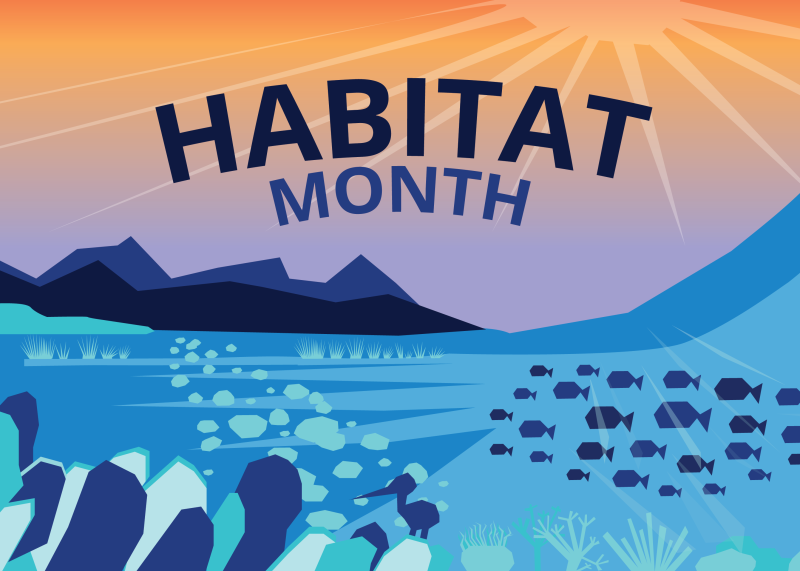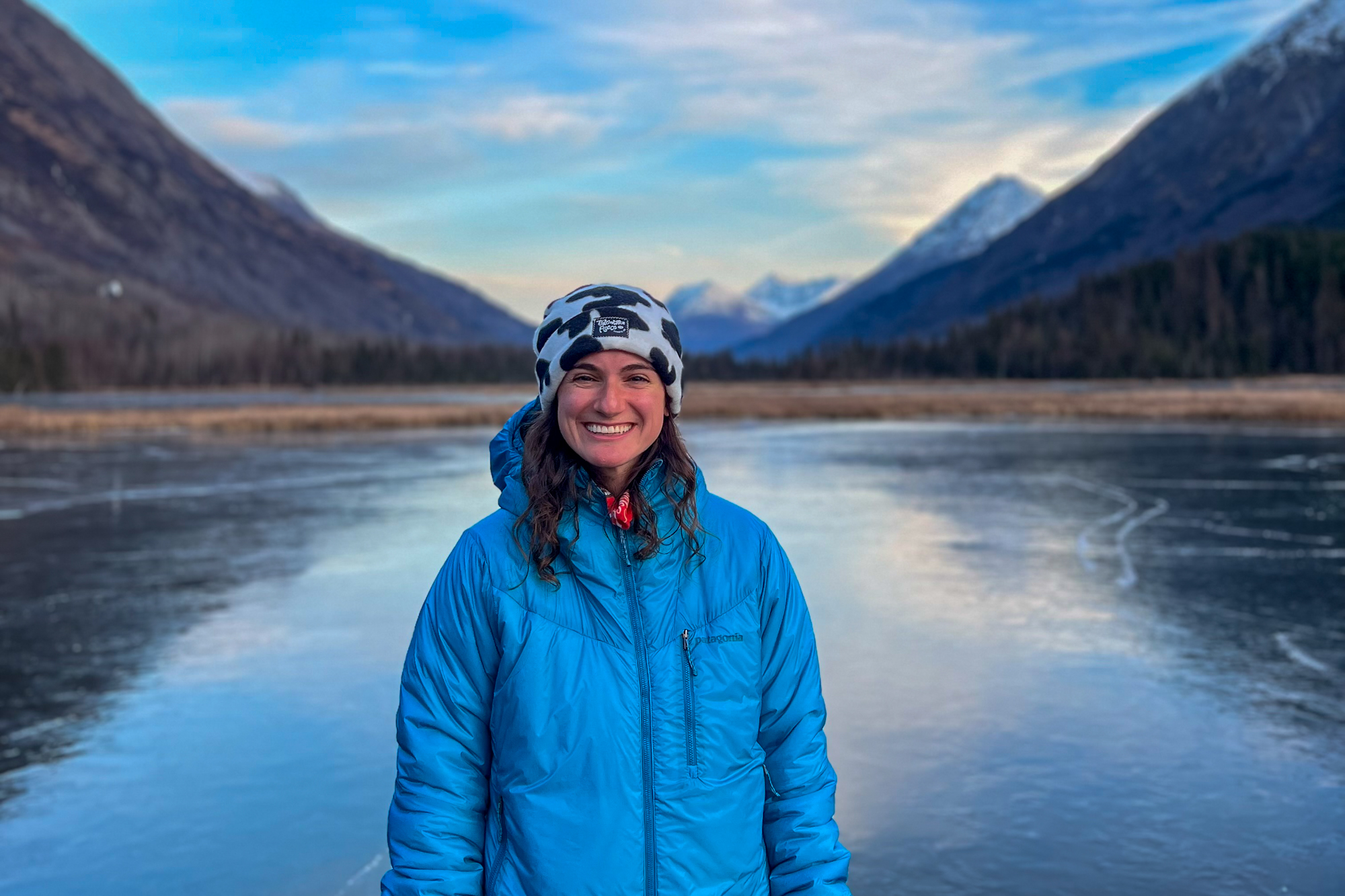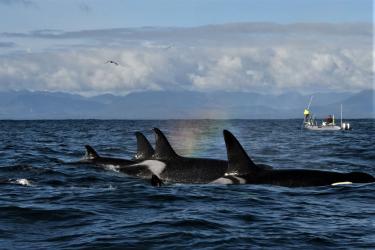We are excited to kick off Habitat Month! All month long, we will share amazing habitat conservation efforts through our website and social media. The theme this year is "Habitat for All.” We will focus on how the Office of Habitat Conservation is working together with our partners to protect and restore healthy habitats across the country. Through inclusive partnerships, we aim to ensure that these vital ecosystems continue to support diverse species and coastal and Great Lakes communities for generations to come.
Follow us here and on X (formerly Twitter) (@NOAAHabitat, #HabitatMonth). Also, be sure to stay up-to-date by subscribing to HabitatNews. Help spread the word about the importance of habitat conservation in making an impact for coastal ecosystems and communities.
Habitat Features
World’s Biggest Dam Removal Project to Open 420 Miles of Salmon Habitat this Fall
With the dams on the lower Klamath scheduled for complete removal by September, salmon will reenter 420 miles of habitat for the first time in a century. NOAA recommends $20 million in funding for additional river restoration.
Read about the dam removal effort
NOAA Recommends Nearly $220 Million in Funding for Transformational Habitat Restoration and Coastal Resilience Projects
Thirty-two new projects will strengthen the climate resilience of coastal ecosystems and communities under the Bipartisan Infrastructure Law and Inflation Reduction Act.
Learn about the projects recommended for funding
NOAA Partners Create Jobs, Train Future Leaders to Advance Habitat Restoration Across the Country
With funding through the Bipartisan Infrastructure Law and Inflation Reduction Act, partners are leading efforts to support current and future restoration practitioners and advance projects that are important to local communities.
Building capacity for habitat restoration
Restoring Resilience–Completion of the West Cove Living Shoreline in Louisiana
In June 2024, NOAA worked with partners to complete the West Cove Living Shoreline–a selected restoration project from the Damage Assessment, Remediation, and Restoration Program’s Final Restoration Plan and Environmental Assessment of the Shell Green Canyon 248 oil spill.
Read about the restoration project
Two NOAA Programs Support Restoration After Coastal Pollution
NOAA is “Growing Habitat Together” through the Damage Assessment, Remediation, and Restoration and the Deepwater Horizon programs.
Learn more about programs for restoration
Gear Up for the Summer Snapper Season with Return ‘Em Right
Gulf offshore anglers: prep for summer reef fish seasons with gear, training, and giveaways to help fish survive.
Read about the Return Em' Right project
Restoring Coral and Stream Banks Through the National Fish Habitat Partnership
Partners are making great strides in habitat restoration and angler engagement projects in Hawaiʻi and Alaska.
About Habitat's Team
Celebrating Habitat Month 2024: Habitat for All
A message from Carrie Selberg Robinson, director of NOAA Fisheries Office of Habitat Conservation, for Habitat Month.
Meet Jonathan Nash, Marine Habitat Resource Specialist
Jonathan is a marine habitat resource specialist for the NOAA Fisheries Office of Habitat Conservation’s Habitat Protection Division in Silver Spring, Maryland.
Learn more about Jonathan's work
Meet Erin Winslow, Marine Habitat Resource Specialist
Erin is a marine habitat resource specialist for the NOAA Fisheries Office of Habitat Conservation’s Habitat Protection Division in Silver Spring, Maryland.
Meet Stephanie Westby, Chesapeake Bay Oyster Restoration Program Manager for the NOAA Restoration Center
Stephanie grew up sailing on the Chesapeake Bay and grew to love all things water. Now, she supports large-scale oyster restoration projects on the estuary as the Chesapeake Bay Oyster Restoration Program Manager for the Office of Habitat Conservation’s Restoration Center.
Learn more about Stephanie's work
Meet Emily Mailman, Marine Habitat Resource Specialist for the NOAA Restoration Center
Emily Mailman is a Marine Habitat Resource Specialist based in Anchorage, Alaska. She supports the work of the Office of Habitat Conservation’s Restoration Center in Alaska.
Meet Lindsay French, Marine Habitat Resource Specialist for the NOAA Restoration Center
Lindsay French is a technical monitor for habitat restoration projects funded under the Bipartisan Infrastructure Law and Inflation Reduction Act in North and South Carolina, Georgia, and Florida
Read more about Lindsay's work
Meet John Barco, Marine Habitat Resource Specialist and Gulf Team Lead for the NOAA Restoration Center
John supports NOAA’s Damage Assessment, Remediation, and Restoration Program to restore habitat in the Southeast.
Meet David Bruce, Ecologist at the NOAA Chesapeake Bay Office
David explores how fish use restored habitat in the Chesapeake Bay.
Chesapeake Summer Interns Join our Team
College students, recent grads gain experience and help the NOAA Chesapeake Bay Office.
Meet Krista McCraken, Marine Habitat Resource Specialist for the NOAA Restoration Center
Krista supports habitat restoration and community resilience in the South Atlantic.
Meet Chemine Jackels, Marine Habitat Specialist for the NOAA Restoration Center
Chemine works as a Technical Monitor supporting habitat restoration projects in the Pacific Northwest.
Habitat Videos, Podcasts, and Story Maps
Video: Largest Salt Marsh Restoration in the Northeast to Bring Back Cape Cod River Herring
NOAA and our partners are helping river herring safely reach their historic spawning grounds by restoring a degraded estuary in Wellfleet, Massachusetts.
Read about the Herring River Restoration Project
Podcast: Teaching Kids to Fish and Love the Water
NOAA Fisheries and partners are working with communities in South Carolina to get kids involved in fishing and environmental conservation.
Story Map: Oyster Reef Restoration in the Chesapeake Bay
Take a virtual tour to learn about how—and why—NOAA and partners are restoring oyster reef habitat in the Chesapeake Bay.






















